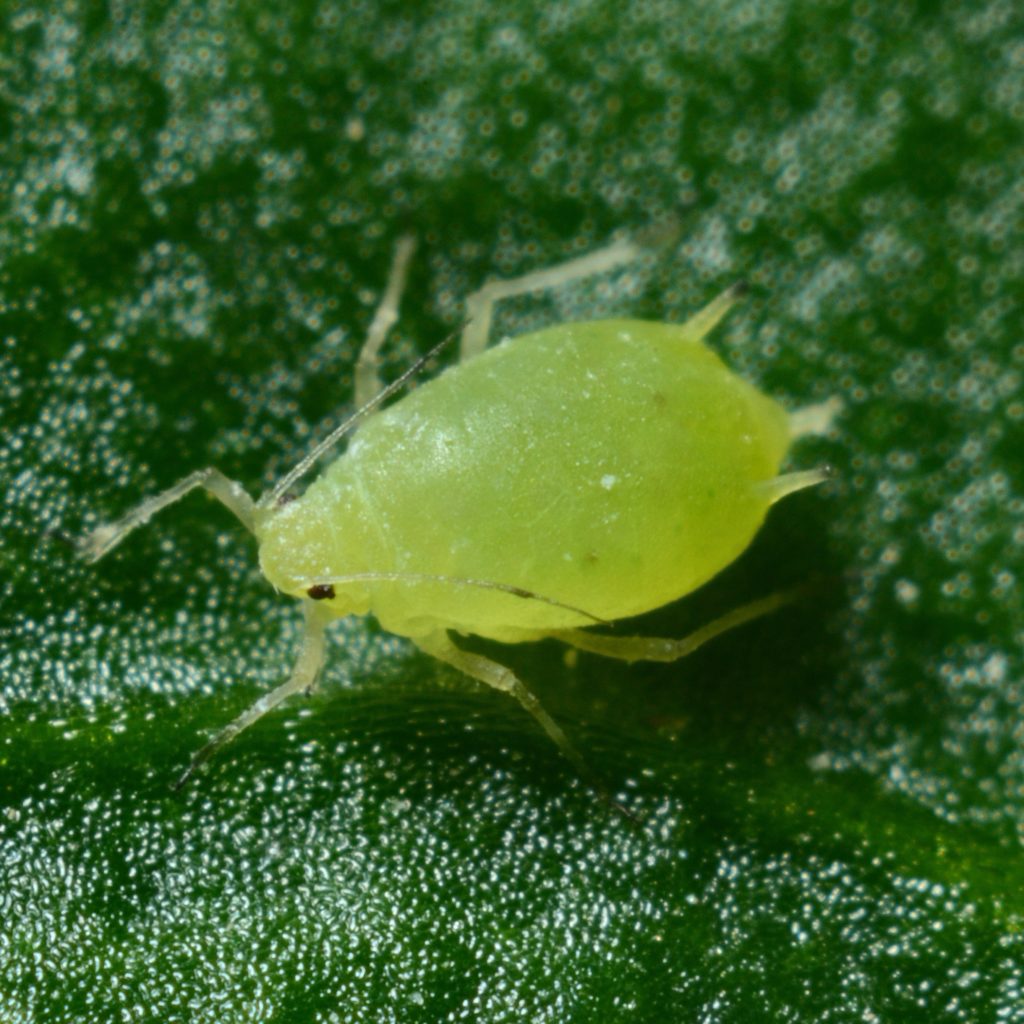Houseplant pests can get out of control quite fast if you don’t identify and treat them quickly. The warmth and light of most indoor growing conditions make the perfect environment for pests to thrive. You should check your plants regularly so you can identify and treat common houseplant pests before they get out of control. It’s common for houseplants that are stressed and unhealthy to be more susceptible to pests. This is why keeping your plants in a healthy environment is important.
Common Signs Of Pests To Look Out For
There are a few common signs to look out for that can help you identify that your houseplant has pests. Leaves that have changed in colour and/or texture can be a sign that your plant has a pest problem. Spotted and speckled leaves, as well as yellowing leaves and stunted growth are the most common signs of pests. Foliage may also grow distorted or irregular.
Some pests exude a sticky substance called honeydew. This then encourages the development of sooty mould to grow on the foliage of your plant, leaving black spots. Webbing on and around the leaves is another sign of pests. The places you should check for pests are on the underside of the leaves, the stem, on leaf joints and on/in new growth.
Common Houseplant Pests
There are a few common houseplant pests that you may encounter on your plants and need to identify. The common houseplant pests are Thrips, Spider Mites, Scale, Mealybugs, Aphids, Whitefly and Fungus Gnats.
| Common Houseplant Pests | Identification |
|---|---|
| Thrips | Small slender insects commonly black in colour but can be brown, white or a greenish yellow. |
| Spider Mites | Reddish brown colour with spider like bodies |
| Scale | Round, oval or flat shaped brown bumps/dots |
| Mealybugs | Soft, small and oval shaped white fuzzy spots |
| Aphids | Small with pear shaped bodies, normally green but can be black or grey in colour as well. |
| Whitefly | Tiny insects that have a yellowish body and white wings. |
| Fungus Gnats | Small and have thin, black bodies with long legs and transparent wings. |
How To Identify And Treat Common Houseplant Pests
Being able to quickly identify common houseplant pests will help you be able to get them under control before they spread to more plants and cause more damage.
1. Thrips
Thrips are one of the most annoying pests you can encounter on your houseplants. They are very tiny bugs that suck the juices out of the leaves, stems, buds and flowers. Since they’re so small and can move from plant to plant very quickly, Thrip infestations can start without you even realising. Not only that, female thrips can reproduce asexually which means they don’t need a male to multiply.
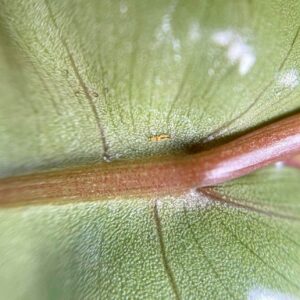
How To Identify Thrips On Houseplants
Thrips are small, slender insects that are generally under a quarter-inch in length at adult size. Adult Thrips can be brown, black or yellow in colour and when they’re in the larvae stage, they are a yellow, greenish colour. The adult Thrips also have small wings, however, they aren’t the strongest flyers. They are generally found on the underside of the leaves in hidden in new growth.
Damage Caused By Thrips
Foliage that is faded or dirty looking is typically the first sign of damage caused by Thrips. The leaves will start off by going a greyish colour before turning brown as it starts to die. Some other damage caused by Thrips are:
- Brown dots on the foliage
- Faded, pale in colour, splotchy leaves
- Dying parts on the leaves
- Flower buds are deformed, falling off or not opening
- Dropping leaves
- Deformed new growth
How To Get Rid Of Thrips
Thrips can build an immunity to chemical pesticide treatments very quickly, making them quite hard to get rid of. If you find them on your houseplants, you should isolate the affected plants immediately to try and slow down/stop them from spreading to other plants. There are a few thing you can do to get rid of Thrips and these are:
- Rinsing the foliage
- Insecticidal soap
- Neem oil
- Beneficial Bugs
Using any of these methods every few days will help to eliminate these stubborn pests. To read more about getting rid of Thrips on houseplants click here.
2. Spider Mites
Spider Mites are one of the most common and most destructive houseplant pests. They are very tiny with spider like bodies and feed on the sap from the plant. Spider Mites can reproduce quite quickly, with the female laying hundreds of eggs at a time, causing infestations to start within days. They also thrive in dry conditions. This is why providing a higher humidity can help stop Spider Mite infestations from starting.
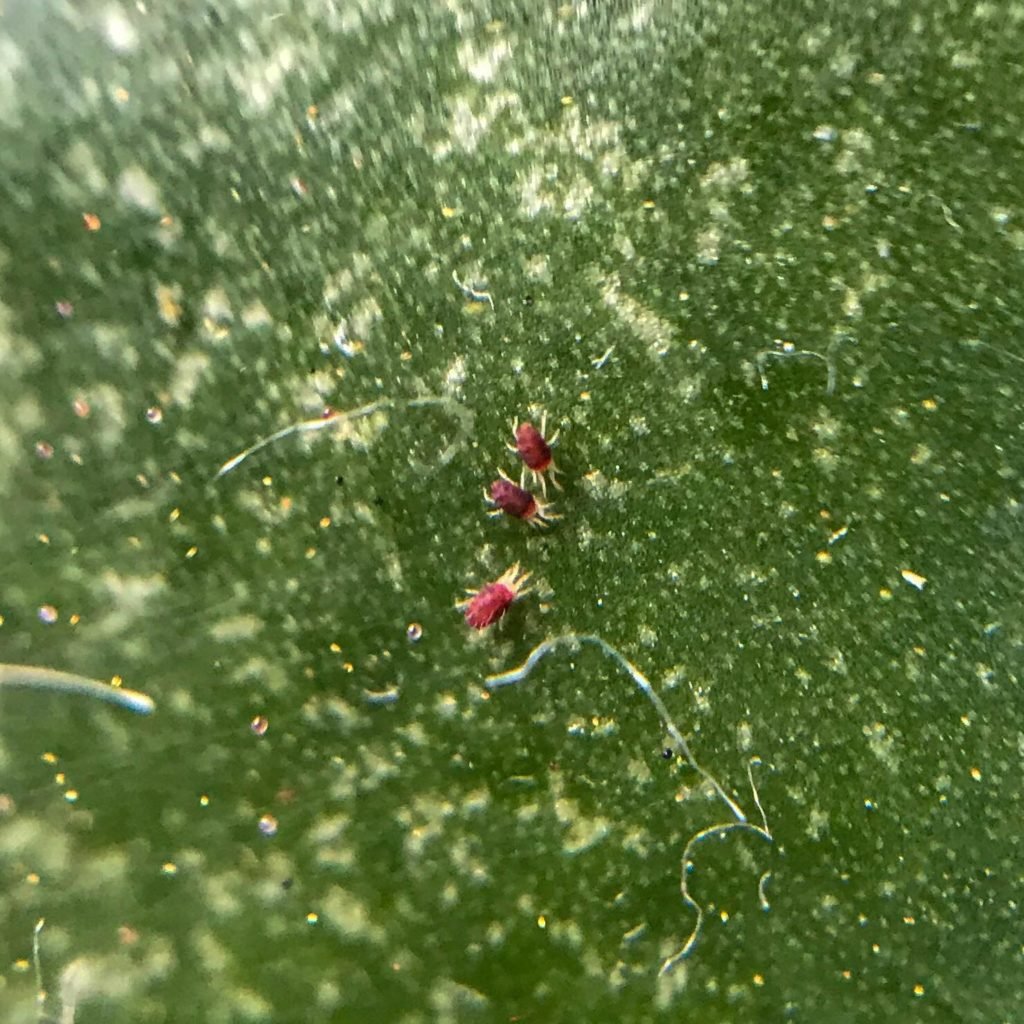
How To Identify Spider Mites On Houseplants
Spider Mites can be easily identified by the webbing they leave around the plants stem and foliage. They are extremely small (less than 1mm in length) and have spider like bodies. They are commonly red in colour but can also be brown, yellow or green. Spider Mites live in colonies and can be hard to spot. They’re typically found on the underside of the leaves and between the leaf joints.
Damage Caused By Spider Mites
Severely infested plants will suffer quite badly and could even lead to plant death. The common symptoms of plants with Spider Mites are mottled and browning leaves, curled or shrivelling leaves, and yellow marks. New growth can also become deformed and overall, the plant will look unhealthy and stressed.
How To Get Rid Of Spider Mites
As soon as Spider Mites are spotted on any houseplants, action to get rid of them should happen immediately. You should also isolate all of the infected plants to try and stop them from spreading to any of your other healthy houseplants. There a few thing you can do to get rid of Spider Mites and these are:
- Wipe down foliage and rinse the plant
- Insecticidal soap
- Increasing humidity
- Neem oil
- Beneficial bugs
Following any of these methods every few days will help to eliminate Spider Mites from your plants. To read more on getting rid of Spider Mites click here.
3. Scale
Scale are a common houseplant pest and can vary in colours, shapes and sizes. If left untreated, a Scale infestation can cover your whole plant. Once they attach to the plant, they become immobile and grow a hard shell. You can find Scale on the leaves, branches and stems of plants.

How To Identify Scale On Houseplants
Scale insects are often a round/oval shape and can range in a few different colours. They are commonly brown or black but can also be orange or white. Scale are quite small, ranging from 1/16 to 1/8 inch long. Unlike other houseplant pests, once Scale attach onto the plant and begin feeding they become immobile. Scale insects will generally appear in clusters, therefore if you spot one, there’s probably going to be more hiding.
Damage Caused By Scale
Depending on the level of the infestation, damage caused by Scale happens quite slowly. The common symptoms of a plant suffering with Scale are yellowing leaves, brown pockmarks and stunted growth. Infested plants may also experience leaf drop.
How To Get Rid Of Scale
Since adult Scale have a hard shell, getting rid of them can sometimes be difficult. Scale can also develop a resistance to chemical pesticides when they’re exposed to them on a daily basis. Organic control is better for the environment and for helping to eliminate Scale insects. There are a few things you can do to get rid of Scale and these are:
- Rubbing alcohol
- Rinsing the plant
- Insecticidal soap
- Neem oil
- Beneficial bugs
- Pruning
Treating the infected plant every few days will help to eliminate Scale from your houseplants. For more information on combating Scale insects on houseplants click here.
4. Mealybugs
Mealybugs are a white, fuzzy pest that sucks the sap from your plants. If left untreated, plants infested with Mealybugs can die. You can find them on the stems, leaves and in the new growth of your houseplants. Plants with a Mealybug infestation should be isolated and treated immediately.
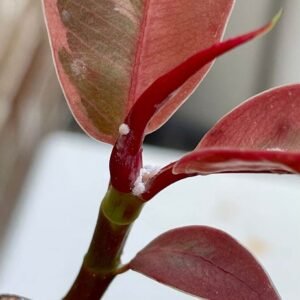
How To Identify Mealybugs On Houseplants
Mealybugs are soft, small (approximately 4mm long) and oval shaped. They can be easily identified by their powdery white colour. Mealybugs are often found grouped together in the leaf joints and on the stems. They also deposit a sticky substance that is called honeydew. This then encourages the development of sooty mould.
Damage Caused By Mealybugs
Plants with a Mealybug infestation will wilt, making it look like it’s dehydrated. Other symptoms can include yellowing and curling leaves, leaf drop, discoloured foliage, distorted and stunted growth. If left untreated, you may even experience plant death.
How To Get Rid Of Mealybugs
As soon as you spot Mealybugs on your houseplants, you should isolate the infected plant to help stop them from spreading to any of your healthy houseplants. There are a few things you can do to get rid of Mealybugs and these are:
- Rubbing alcohol
- Rinsing the plant
- Insecticidal soap
- Neem oil
- Beneficial bugs
Treating your plant for Mealybugs every few days will help to eliminate them completely. For more information on getting rid of Mealybugs click here.
5. Aphids
Aphids are another sap sucking pest that suck the nutrient-rich sap from all kinds of different plants. They’re generally found on the underside of the leaves, on the plants stem and on flower buds. Aphids can be easier to spot as they cluster together in large groups.
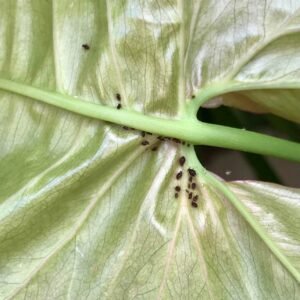
How To Identify Aphids On Houseplants
Aphids are small (1/8 inch long) and have pear shaped bodies. They can be green, grey, white, brown, yellow or black in colour. Some can even be white and woolly looking. Aphids generally arrive in colonies and can reproduce quickly. They are typically found on the underside of the leaves and on the stems of plants.
Damage Caused By Aphids
The common symptoms of a plant suffering from Aphids are stunted growth, distorted and yellowing leaves. As Aphids feed on the plant, they deposit a sticky substance called honeydew. This then causes the development of sooty mould. Aphids are also known to spread viruses to other plants.
How To Get Rid Of Aphids
If any of your plants are suffering from an Aphid infestation, you should isolate them immediately and begin treating them. There are a few ways to help get rid of Aphids and these are:
- Rinsing the plant
- Insecticidal soap
- Neem oil
- Horticultural oil
- Beneficial bugs
Treating Aphids every few days will help to eliminate them completely. For more on Aphids control and treatment click here.
6. Whitefly
Whitefly are little insects that suck the sap from the plants leaves. You can generally tell if your plant has Whitefly because you will see them fly off when you move the infected plant. If left untreated, they can cause plant death.
How To Identify Whitefly On Houseplants
Whitefly are tiny (2-3mm long) insects and have a yellowish body and white wings. They look kind of like a moth. The nymphs have a flat, oval body that looks similar to Scale insects. Whitefly are often found on the underside of the leaves and fly away if the plant is moved. The adult females will also lay their eggs on the underside of the leaves.
Damage Caused By Whitefly
Whitefly suck the sap from the plants foliage and as they’re feeding, they also deposit honeydew. The honeydew then encourages the development of sooty mould. Other common symptoms a plant will show when suffering from a Whitefly infestation is stunted growth, distorted leaves, yellowing and drooping leaves. In severe cases, Whitefly can cause plant death.
How To Get Rid Of Whitefly
If any of your plants have a Whitefly infestation, you should isolate and start treating them straight away. There are a few things you can try to get rid of Whitefly and these are:
- Rinse the plant
- Sticky Traps
- Insecticidal soap
- Prune leaves
- Neem oil
Treating Whitefly every few days will help to eliminate them from your houseplants.
7. Fungus Gnats
Fungus Gnats are little bugs that live in the soil of your houseplants and feed on the fungus in the soil and on the plants roots. They’re typically more annoying to us than they are to the plant. However, with a severe Fungus Gnat infestation, you may notice some damage to the plant.
How To Identify Fungus Gnats On Houseplants
Fungus Gnats are small (approximately 1/16 to 1/8 inch long) and have thin, black bodies with long legs and transparent wings. They look similar to fruit flies and mosquitos. Unlike most other common houseplant pests, Fungus Gnats don’t feed on the foliage of the plants. Instead, they live in the soil and feed on the fungus. The larvae like to feed on the fungus, organic matter and sometimes the plants roots. Fungus Gnat larvae are tiny and transparent with black, shiny heads.
Damage Caused By Fungus Gnats
In severe infestations, Fungus Gnat larvae will chew holes in the plants roots. This causes the foliage to start going yellow, the plant will begin wilting and it can cause plant death. When there’s only a small quantity of Fungus Gnats in the soil, the plant generally won’t show any signs of stress. You will only notice when you water or move the pot, you’ll see them buzzing around the area.
How To Get Rid Of Fungus Gnats
Getting rid of Fungus Gnats isn’t too difficult when compared to other pests. There are a few things you can try to get rid of Fungus Gnats and they are:
- Allow soil to dry out
- Sticky traps
- Apple cider vinegar traps
- Sand or gravel on top of the soil
- Repotting plant
Following any of these will help to eliminate Fungus Gnats from your plant and home. For more information on getting rid of Fungus Gnats click here.

